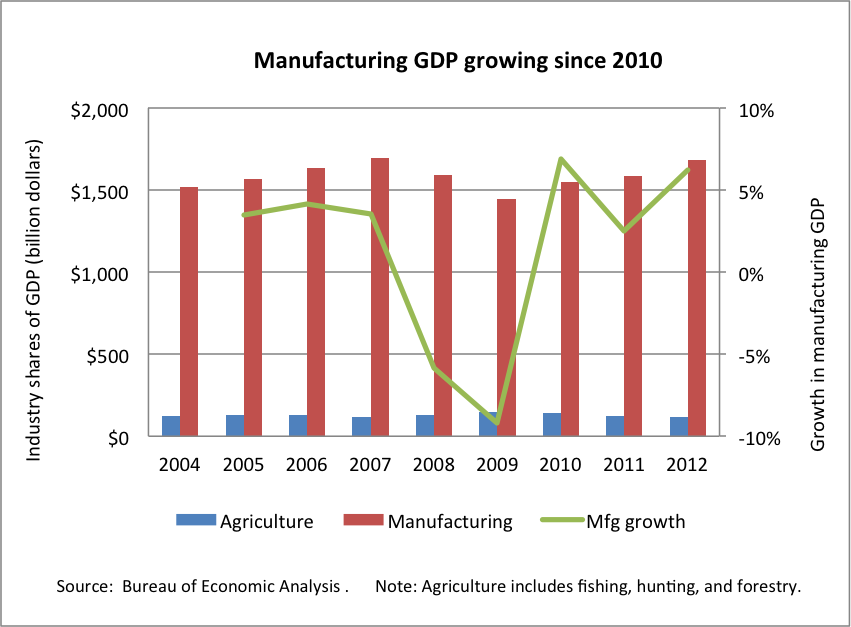Manufacturing Innovation Blog
Powered by the Manufacturing Extension Partnership

The difference between a myth and a reality can be as stark as the difference between day and night. Indeed, the gap between popular perception and reality about the state of US manufacturing is even more interesting when one looks at the data. A lengthy part of my professional experience comes from working as an economist in the agriculture sector. As a new member of the community of “manufacturing analysts”, I have observed with amazement that there is a disconnect between perception and reality about the state of U.S. manufacturing. It may be just me, but I don’t hear much about the declining significance of U.S. agriculture as I often do about manufacturing. In fact, listening to some people not familiar with the data and industries, one tends to walk away with the feeling that the agriculture industry is a much more significant contributor to the US economy than manufacturing. This perception is part of a broader false notion that US manufacturing is either on life support or dying, and that its contribution to the overall economy is on the decline.
But nothing can be further from the truth. It is likely that the pessimistic view of the manufacturing sector is perpetuated by a single set of numbers—the manufacturing jobs data. While it is true that U.S. manufacturing jobs have declined, on average, in the last decade, that pattern it not unique to only the United States. Declining manufacturing jobs have been observed across most advanced economies. Even so, job statistics alone should not define the overall performance of the U.S. manufacturing industry. A closer look at the data paints a totally different picture of the relative performance of the manufacturing industry. According to some industry estimates, U.S. manufacturing supports about 17.2 million jobs, equivalent to 9 percent of total employment. Agriculture, on the other hand, accounts for about 2 percent of total U.S. employment, averaging 1.3 million jobs in the last decade.
Manufacturing accounted for about 12 percent ($1.87 trillion) of U.S. gross domestic product in 2012, while agriculture’s share was 1 percent ($171.23 billion) in that same period. Yes, manufacturing value-added to US 2012 GDP was 11 times that of agriculture’s. The numbers have been pretty stable going back four years—the contributions of the agriculture and manufacturing industries to the U.S. economy averaged 1.1 percent and 11.2 percent, respectively, from 2009 to 2011. In fact, durable-goods manufacturing has been the biggest single driver of overall growth in the economy in recent years, rising 13.3 percent, 6.8 percent, and 9.1 percent in 2010, 2011 and 2012, respectively.
The recent growth in U.S. manufacturing output is not surprising. Manufacturing accounts for an estimated 70 percent of all private sector R&D in the United States. Furthermore, industry analysts have identified keys trends—rising U.S. productivity, declining cost of energy, and a reduction in the bottlenecks associated with long supply chains—that would minimize the asymmetry between U.S. and foreign cost of production, and put U.S. manufacturing on a much more competitive trajectory.
But these positive developments are often lost in the midst of the deep disconnect between the myth and reality about manufacturing. As shown in the graph below, manufacturing output experienced positive growth for past three consecutive years, and the output has historically dwarfed agricultural GDP, contrary to some of the myths. In fact, there is ongoing debate about whether the recent positive trends in U.S. manufacturing represent a wider resurgence, driven by a structural shift, or just the normal cyclical recovery. While a three-year period may be too short to ascertain the existence of a manufacturing renaissance, the preponderance of evidence appears to be pointing in the direction of a positive structural transformation in U.S. manufacturing.

About the author
Related Posts
Comments
- Reply

